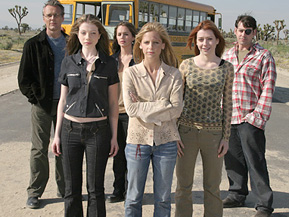|
|
Mythology: Buffy the Vampire Slayer's ImpactBy Martin FelipeOctober 30, 2009
Buffy is more like a novel for television. All of the episodes contribute to a big picture, a picture the viewer may not see at first, but will become clear as the story reveals itself. Now this is a lofty goal for television, a commerce-based art form, which, at least at the time, relied on viewers for profitability. Problem is, the complexity of the narrative, the ever-evolving status quo had the potential to alienate casual viewers. As much as the show had a passionate following of fans who would never dare miss an episode, it also left many confused or afraid that they'd never be able to catch up. In today's landscape, with DVD, TiVo and Hulu, it's far easier for viewers to catch up, but Buffy's heyday was just prior to that revolution. The fact that so many novelistic shows have since sprung up on the cable networks and even on the networks is due more to this technology than to Buffy's success. While from week to week, such shows may not see the numbers that a House or a NCIS might, there's a new pastime of people watching season DVD sets and enjoying the long tale that they might have not had the time or commitment for in weekly installments. One of the first shows to benefit from this new viewing habit is 24, a show which nearly got cancelled after its first season. FOX released the season on DVD prior to the second season premier and now has a show than not only became one of their more prominent hits, but also has gotten to the overstaying-its-welcome phase of its run. Of course, not all serialized mythology shows enjoy 24's ratings success, but they are profitable in their own way because of DVD sales or demographic desirability. The audience for these programs may be small, in first run anyway, but they're loyal, a predictable well of potential consumers for advertisers to target. Contrast this with the mega-crowds that consume weekly doses of CSI, but without passion or investment. Sponsors can see value in both types of viewers, which keep many of Buffy's progeny alive as a valuable commodity. Which, in turn, makes me happy. Because, Heroes notwithstanding, I love these shows. I do think it's the highest form of television art. I'm resigned that they'll never be the ratings giants that CBS's procedurals are. I'll take their DVD success as a consolation prize. There are tons of profits to be made with these things, as evidenced by their saturation in the scripted-television market. As TV continues to splinter, the door will continue to open to the possibilities of television as a medium for quality storytelling. Now, if only Whedon's latest Dollhouse were profitable enough for FOX to grant him another miraculous season. That's highly unlikely at this point. They'll probably replace it with another vampire show.
|

|
|
|

|
Friday, November 1, 2024
© 2024 Box Office Prophets, a division of One Of Us, Inc.


